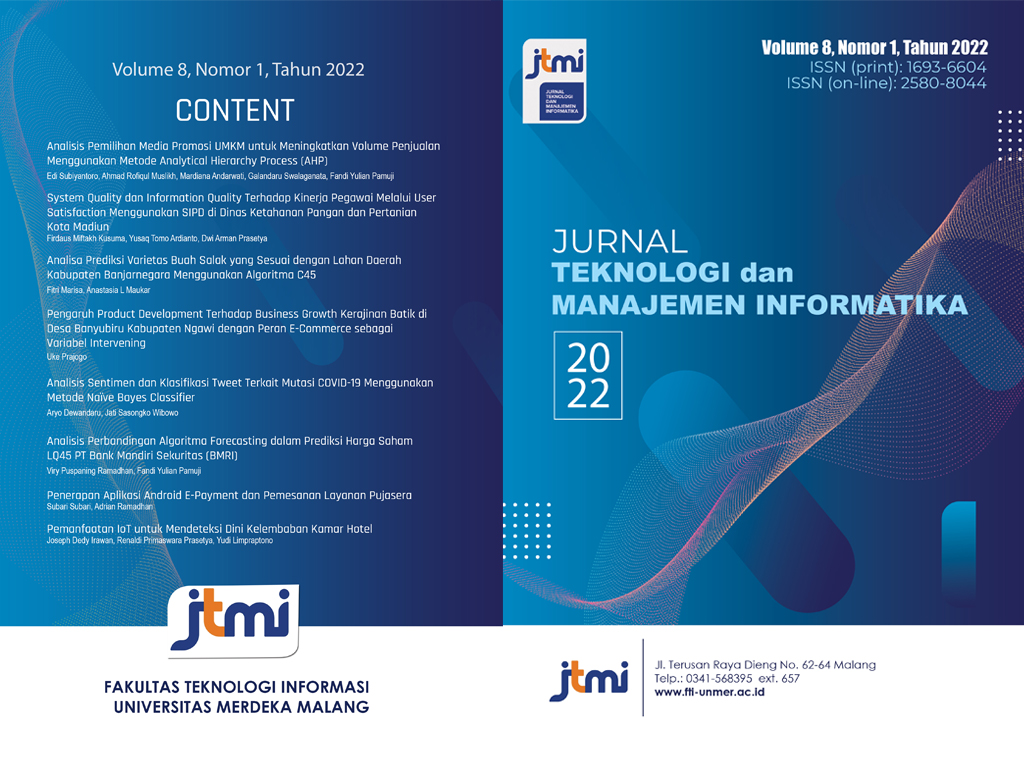Analisis Sentimen dan Klasifikasi Tweet Terkait Mutasi COVID-19 menggunakan Metode Naïve Bayes Classifier
DOI:
https://doi.org/10.26905/jtmi.v8i1.6803Keywords:
COVID-19, Sentiment Analysis, Nave Bayes Classifier, Text MiningAbstract
Towards the end of 2019 in Wuhan City, China, a new type of Corona Virus was discovered which has the scientific name COVID-19 and is a type of virus that causes acute disorders in the human respiratory system. The spread of this virus is very fast and causes mutations of this virus to a more lethal stage than before. Thus, sentiment analysis is expected to be able to determine the trend of public assessment of the COVID-19 mutation. Naïve Bayes Classifier is a method used in research. This method can classify data or opinions into two sentiments, namely positive and negative. The research data comes from Twitter which is taken using the Twitter API with the keyword "covid mutation", for data processing several processes are carried out, namely sentiment classification, data cleaning, and preprocessing so that the final result is obtained. The test results from this study show that the Naïve Bayes Classifier method has an accuracy of 86.67% with an f1-score of 82.00% on positive sentiment and 89.00% on negative sentiment. Based on the results of the study, it can be concluded that the Naïve Bayes Classifier method can be used to analyze sentiment data from tweets about the COVID-19 mutation with an accuracy of 86.67%.Downloads
References
M. K. Dr. Mashuri Masri, S.Si., M. K. Delima Engga Maretha, S.Pd., and M. S. Rusny, S.Pt., Everything About Corona. 2020.
E. Parwanto, “Virus Corona (SARS-CoV-2) penyebab COVID-19 kini telah bermutasi,†J. Biomedika dan Kesehat., vol. 4, no. 2, 2021, doi: 10.18051/jbiomedkes.2021.v4.47-49.
S. Samsir, A. Ambiyar, U. Verawardina, F. Edi, and R. Watrianthos, “Analisis Sentimen Pembelajaran Daring Pada Twitter di Masa Pandemi COVID-19 Menggunakan Metode Naïve Bayes,†J. Media Inform. Budidarma, vol. 5, no. 1, pp. 157–163, 2021.
D. Ariyanti and K. Iswardani, “Teks Mining untuk Klasifikasi Keluhan Masyarakat Pada Pemkot Probolinggo Menggunakan Algoritma Naïve Bayes,†J. IKRA-ITH Inform., vol. 4, no. 3, 2020.
R. Rasenda, H. Lubis, and R. Ridwan, “Implementasi K-NN Dalam Analisa Sentimen Riba Pada Bunga Bank Berdasarkan Data Twitter,†J. MEDIA Inform. BUDIDARMA, vol. 4, no. 2, 2020, doi: 10.30865/mib.v4i2.2051.
A. Harun and D. P. Ananda, “Analisa Sentimen Opini Publik Tentang Vaksinasi Covid-19 di Indonesia Menggunakan Naïve Bayes dan Decission Tree,†Indones. J. Mach. Learn. Comput. Sci., vol. 1, no. April, 2021.
F. A. Maulana, I. Ernawati, P. Labu, and J. Selatan, “Analisa sentimen cyberbullying di jejaring sosial twitter dengan algoritma naïve bayes,†Semin. Nas. Mhs. Ilmu Komput. dan Apl. (SENAMIKA, 2020.
F. Ratnawati, “Implementasi Algoritma Naive Bayes Terhadap Analisis Sentimen Opini Film Pada Twitter,†INOVTEK Polbeng - Seri Inform., vol. 3, no. 1, 2018, doi: 10.35314/isi.v3i1.335.
E. T. Handayani and A. Sulistiyawati, “Analisis Setimen Respon Masyarakat Terhadap Kabar Harian Covid-19 Pada Twitter Kementerian Kesehatan Dengan Metode Klasifikasi Naive Bayes,†J. Teknol. dan Sist. Inf., vol. 2, no. 3, pp. 32–37, 2021.
J. Song, K. T. Kim, B. Lee, S. Kim, and H. Y. Youn, “A novel classification approach based on Naïve Bayes for Twitter sentiment analysis,†KSII Trans. Internet Inf. Syst., vol. 11, no. 6, pp. 2996–3011, 2017.
D. Rustiana and N. Rahayu, “ANALISIS SENTIMEN PASAR OTOMOTIF MOBIL: TWEET TWITTER MENGGUNAKAN NAÃVE BAYES,†Simetris J. Tek. Mesin, Elektro dan Ilmu Komput., vol. 8, no. 1, 2017, doi: 10.24176/simet.v8i1.841.
Downloads
Additional Files
Published
Issue
Section
License
Authors who publish with this journal agree to the following terms:
(1)Â Copyright of the published articles will be transferred to the journal as the publisher of the manuscripts. Therefore, the author confirms that the copyright has been managed by the journal.
(2) Publisher of JTMI: Jurnal Teknologi dan Manajemen Informatika is University of Merdeka Malang.
(3) The copyright follows Creative Commons Attribution–ShareAlike License (CC BY SA): This license allows to Share — copy and redistribute the material in any medium or format, Adapt — remix, transform, and build upon the material, for any purpose, even commercially.




